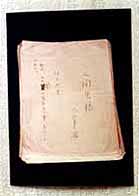|
Top Picks || Arts & Entertainment || Business & Economy || Education & Society ||
DAZAI IS BACK: Modern Writer a Hit with Postmodern Young September 10, 1998  An original handwritten draft of No Longer Human. (Jiji Press; courtesy of Shinchosha) Two Japanese writers have won the Nobel Prize in literature--Kenzaburo Oe and Yasunari Kawabata--and others, like Yukio Mishima and Kobo Abe, are renowned overseas through translations of many of their works. But there is one writer whose popularity within Japan puts him ahead of them all: Osamu Dazai. Born to a wealthy family in the poor northern Tohoku region, he suffered a life of dissipation, frequent failure, and illness before committing suicide in 1948 at the age of 39. But Dazai's work transcends his period: His writing is enjoying new popularity half a century after his death. Dazai Celebrated across Japan Meanwhile, in Mitaka, the scene of Shayo (translated as The Setting Sun) and other works, a citizens' group has begun training tourist guides to take people around the locations connected with Dazai. Dazai's birthplace in Kanagi Town, Aomori Prefecture, for many years used as an inn, has been restored to its original state; it was reopened as a museum in April 1998. In the mountainous center of Honshu, a Yamanashi Prefecture association providing tourist information has set up within its Web site a page featuring the Kofu city inn where Dazai stayed and wrote novels, and detailing trails that follow in his footsteps. Another proof of Dazai's undying popularity is the annual remembrance gathering on June 19, the day of both his birth and death. This year's gathering was packed with young people. "What he writes about is like what goes on inside myself," said one university student who attended. "I can empathize with him much more than with recent writers." A high-school student adds that Dazai's writing approach and the atmosphere of his works are unlike those of current writers. According to one person involved with the remembrance event, "Many Dazai fans feel they have a personal claim on him; they've always been a tough breed to deal with." A psychiatrist ascribes Dazai's continuing popularity to his "visionary understanding of the psychology of today's youth, with their preoccupation with finding a meaning and purpose in life." Secret of Dazai's Popularity Prominent Japanese novelist and dramatist Hisashi Inoue pinpoints two key features that make Dazai's work appealing. First, "Dazai writes as though he were a guardian angel in the temporal world watching over those who, like him, live foolish lives because they are weak and yielding. This role is his source of inspiration in his novel writing." Second, Inoue says, is his singular narrative style. It has a distinctive tone, nurtured by the storytelling style that characterizes traditional Japanese performing-art forms like folk tales, kabuki theater, and rakugo humorous stories. These are the characteristics that make Dazai's stories accessible and fascinating to read.
 Edited by Japan Echo Inc. based on domestic Japanese news sources.
Articles presented here are offered for reference purposes and
do not necessarily represent the policy or views of the Japanese
Government. Edited by Japan Echo Inc. based on domestic Japanese news sources.
Articles presented here are offered for reference purposes and
do not necessarily represent the policy or views of the Japanese
Government.
|
